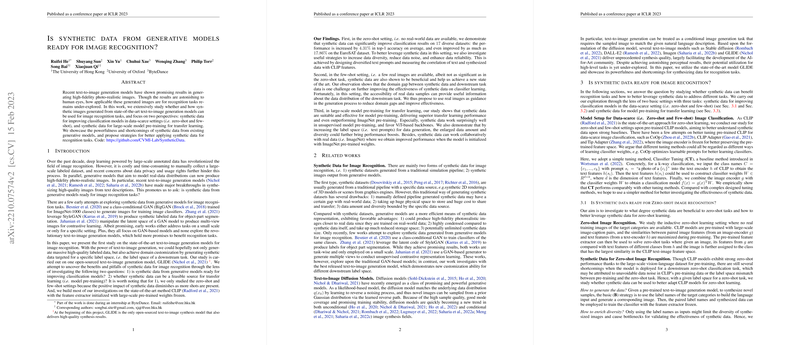Analyzing the Feasibility of Synthetic Data for Enhancing Image Recognition
The paper, "Is synthetic data from generative models ready for image recognition?" by Ruifei He et al., undertakes a detailed investigation into the viability of synthetic images generated by state-of-the-art text-to-image models for image recognition tasks. The paper evaluates the capacity of such synthetic data to augment classification models in environments with limited data availability and for large-scale model pre-training, enhancing transfer learning capabilities. Through a methodological exploration, this paper assesses both the strengths and areas for improvement in current generative models, providing strategies to optimally utilize synthetic data for numerous image recognition tasks.
Key Findings
- Zero-shot and Few-shot Learning Improvements:
- Zero-shot Learning: Synthetic data considerably enhanced classification performance across 17 datasets, improving an average top-1 accuracy by 4.31% in many cases and significantly, by 17.86% on EuroSAT. Strategies like language enhancement via diverse text prompts and CLIP-based filtering were deemed instrumental in maximizing data reliability and diversity.
- Few-shot Learning: The introduction of real-shot data in addition to synthetic data set new performance standards across various datasets. While synthetic data's benefits decrease as more real data is available, synthetic data still notably boosted performance in data-scarce conditions.
- Pre-training Efficacy in Transfer Learning:
- Synthetic data showcased strong potential in pre-training contexts, especially in unsupervised settings, surpassing results from traditional ImageNet-based pre-training. Increasing synthetic data diversity and amount, alongside model initialization using ImageNet pre-trained weights, proved to be fruitful strategies.
Implications and Future Directions
The research suggests that synthetic data holds promise in enhancing algorithm performance particularly in zero-shot and few-shot learning environments. Such data provides a cost-effective solution in scenarios where annotated data is scarce, expensive, or has privacy concerns. The demonstration of transfer learning efficacy offers prospective utilization in broader applications, suggesting that a combined use of synthetic and real-world data might further enhance model robustness and generalization.
Challenges and Considerations
One inherent challenge is the domain gap between synthetic and real data, impeding the potential for synthetic data to entirely replace real-world examples. Despite promising results with generated images, their diversity and quality still fall short compared to real datasets without careful augmentation and filtering strategies.
Furthermore, while generative models like GLIDE produce aesthetically impressive outputs, their applicability in yielding high-fidelity, domain-specific data suitable for various recognition tasks needs refinement. Future work should explore more sophisticated generative models capable of reduced domain error and increased label space representation, potentially incorporating real-time guidance via limited real dataset interactions.
Conclusion
The paper provides empirical evidence that synthetic data, especially from contemporary text-to-image generators, is increasingly ready to support image recognition tasks. By employing appropriate strategies to enhance their diversity and reduce noise, synthetic datasets can effectively boost learning in conditions where traditional data acquisition is impractical. This notion advances the discourse on generative AI's role in modern machine learning workflows, particularly in contexts demanding rapid adaptation and learning.
